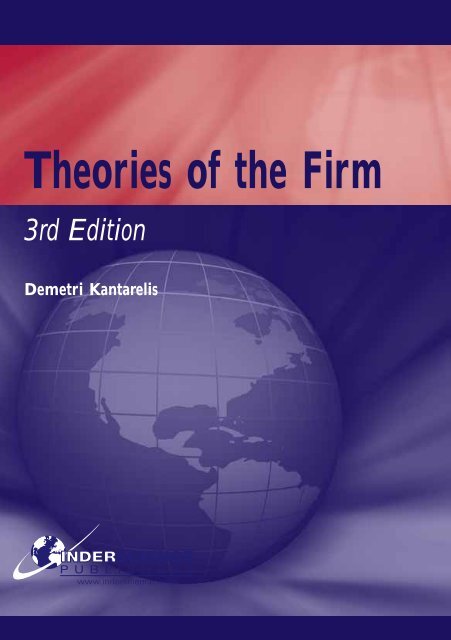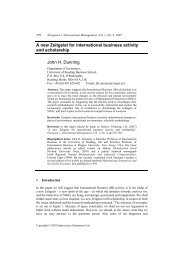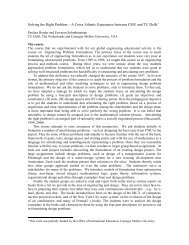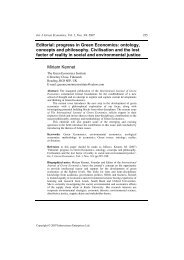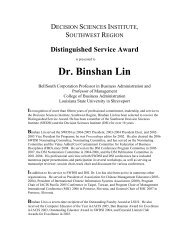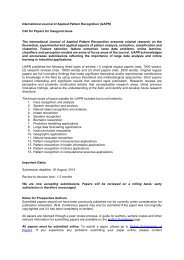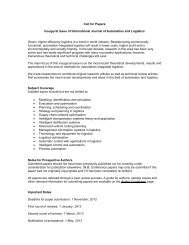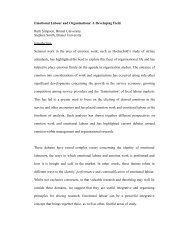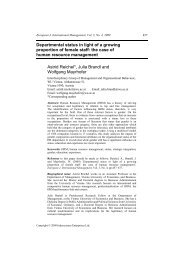Theories of the Firm
Theories of the Firm
Theories of the Firm
You also want an ePaper? Increase the reach of your titles
YUMPU automatically turns print PDFs into web optimized ePapers that Google loves.
<strong>Theories</strong> <strong>of</strong> <strong>the</strong> <strong>Firm</strong><br />
3rd Edition<br />
Demetri Kantarelis
Introduction<br />
<strong>Theories</strong> <strong>of</strong> <strong>the</strong> <strong>Firm</strong><br />
3rd Edition<br />
Demetri Kantarelis<br />
A business firm is a needs-satisfying machine; it is an entity<br />
invented and employed by society to better satisfy <strong>the</strong><br />
society’s interests. A society is better <strong>of</strong>f when properly<br />
regulated business firms are allowed to carry <strong>the</strong> bulk <strong>of</strong><br />
economic activity than when <strong>the</strong>y are not allowed to exist or<br />
are severely regulated by <strong>the</strong> state. And, as history has<br />
documented, societies fare better when <strong>the</strong>y are dependent<br />
on such business firms than when <strong>the</strong>y are dependent on<br />
central planning.<br />
The business firm generates consumer satisfaction in return<br />
for income that gets distributed to its owners, employees,<br />
suppliers and public goods recipients. Any firm <strong>of</strong> any size is<br />
in existence because:<br />
• it identifies a consumer need and develops/invents a recipe on how to satisfy that<br />
need<br />
• it makes <strong>the</strong> right decisions with respect to making or buying inputs so that it<br />
delivers its recipe at <strong>the</strong> lowest possible cost<br />
• it provides <strong>the</strong> best incentives to its stakeholders and because • it constantly and<br />
deliberately evolves through <strong>the</strong> relentless pursuit <strong>of</strong> competitive,<br />
organisation and strategic advantage.<br />
This book describes four <strong>the</strong>ories about <strong>the</strong> firm that have emerged since Adam Smith’s<br />
An Inquiry into <strong>the</strong> Nature and Causes <strong>of</strong> <strong>the</strong> Wealth <strong>of</strong> Nations. These <strong>the</strong>ories are: The<br />
Neoclassical Theory, The Transactions Cost Theory, The Principal-Agent Theory, and The<br />
Evolutionary Theory.<br />
The Neoclassical Theory <strong>of</strong> <strong>the</strong> <strong>Firm</strong>, in its basic form, views <strong>the</strong> firm as a black box<br />
rational entity. The <strong>the</strong>ory is built on imaginary but plausible production and demand<br />
functions and it establishes <strong>the</strong> principal <strong>of</strong> pr<strong>of</strong>it maximisation according to which pr<strong>of</strong>it<br />
is maximised when marginal revenue is equal to marginal cost. The <strong>the</strong>ory may be used<br />
to, among many o<strong>the</strong>r things, describe various market structures, regulation issues,<br />
strategic pricing, barriers to entry, economies <strong>of</strong> scale and scope and even optimum<br />
portfolio selection <strong>of</strong> risky assets. The main weakness <strong>of</strong> <strong>the</strong> <strong>the</strong>ory is that it assumes<br />
complete information and, as a result, <strong>the</strong>re is no agency problem or concern for<br />
transaction costs due to conflict between owners and suppliers <strong>of</strong> inputs (even specific<br />
to whatever <strong>the</strong> firm produces) in <strong>the</strong> market system. Ano<strong>the</strong>r weakness <strong>of</strong> <strong>the</strong> <strong>the</strong>ory is<br />
that it does not allow for firm evolution.<br />
The Transactions Cost Theory <strong>of</strong> <strong>the</strong> <strong>Firm</strong> focuses on problems <strong>of</strong> asymmetric<br />
information involved in transactions. The firm, according to this <strong>the</strong>ory, comes into<br />
existence because it successfully minimises ‘make’ inputs costs (through vertical<br />
integration) and ‘buy’ inputs costs (using available markets). The more specific <strong>the</strong> inputs<br />
that <strong>the</strong> firm needs are, <strong>the</strong> more likely it is that it would produce <strong>the</strong>m internally and/or<br />
acquires <strong>the</strong>m through joint ventures and alliances. The weakness <strong>of</strong> this <strong>the</strong>ory is that it<br />
visit<br />
www.inderscience.com
does not take into consideration agency costs or firm evolution nei<strong>the</strong>r it explains how<br />
vertical integration should take place in <strong>the</strong> face <strong>of</strong> investments in human assets, with<br />
unobservable value, that cannot be transferred.<br />
The Principal-Agent Theory <strong>of</strong> <strong>the</strong> <strong>Firm</strong> extends <strong>the</strong> neoclassical <strong>the</strong>ory by adding<br />
agents to <strong>the</strong> firm. The <strong>the</strong>ory is concerned with friction due to asymmetric<br />
informationbetween owners <strong>of</strong> firms and <strong>the</strong>ir stakeholders or managers and<br />
employees; <strong>the</strong> friction between agent and principal, requires precise measurement <strong>of</strong><br />
agent performance and <strong>the</strong> engineering <strong>of</strong> incentive mechanisms. The weaknesses <strong>of</strong><br />
<strong>the</strong> <strong>the</strong>ory are many: it is difficult to engineer incentive mechanisms, it relies on<br />
complicated incomplete contracts (borderline unenforceable), it ignores transaction<br />
costs (both external and internal), and it does not allow for firm evolution.<br />
The Evolutionary Theory <strong>of</strong> <strong>the</strong> <strong>Firm</strong> places emphasis on production capabilities and<br />
process as well as product innovation. The firm according to this <strong>the</strong>ory possesses<br />
unique resources, tied semi-permanently to <strong>the</strong> firm, and capabilities; <strong>the</strong> firm’s<br />
recourses can be classified into four categories: financial, physical, human and<br />
organisational. The <strong>the</strong>ory sees <strong>the</strong> firm as a reactor to change and a creator <strong>of</strong> change<br />
for competitive advantage. The firm, as a creator <strong>of</strong> change, may cause creative<br />
destruction, which in turn may give birth to new industries and enable sectors <strong>of</strong>, or<br />
entire, economies to grow. Although many countries have established architectures to<br />
support entrepreneurial endeavours, a weakness <strong>of</strong> <strong>the</strong> <strong>the</strong>ory remains: process and<br />
product innovation (especially <strong>the</strong> latter) are mostly due to serendipity and as a result<br />
‘entrepreneurship’ is a very expensive factor <strong>of</strong> production; in <strong>the</strong> pursuit <strong>of</strong> pr<strong>of</strong>it and<br />
general well-being, it cannot be easily programmed within a firm or a nation.<br />
The book consists <strong>of</strong> nine chapters followed by an epilogue:<br />
• Chapters 1 and 2 describe <strong>the</strong> external environment <strong>of</strong> <strong>the</strong> firm and <strong>the</strong> firm’s<br />
decision-making process with emphasis on strengths and weaknesses <strong>of</strong> <strong>the</strong><br />
following models: rational, satisficing, probabilistic (inclusive <strong>of</strong> Bayesian),<br />
cost/benefit and behavioural.<br />
• Chapters 3–6 are devoted to <strong>the</strong> Neoclassical Theory <strong>of</strong> <strong>the</strong> <strong>Firm</strong> and some <strong>of</strong> its<br />
applications ranging from market structures to managing a portfolio <strong>of</strong> risky<br />
assets and from free pricing to regulation.<br />
• Chapter 7 describes <strong>the</strong> Transactions Cost Theory <strong>of</strong> <strong>the</strong> <strong>Firm</strong> and its variants as<br />
well as hybrids (structures between <strong>the</strong> extremes <strong>of</strong> markets and hierarchies).<br />
• Chapter 8 focuses on <strong>the</strong> Principal-Agent Theory <strong>of</strong> <strong>the</strong> <strong>Firm</strong>, <strong>the</strong> central problem<br />
<strong>of</strong> which is how to induce <strong>the</strong> agent to act in <strong>the</strong> best interests <strong>of</strong> <strong>the</strong> principal<br />
when <strong>the</strong> agent has an informational advantage over, and different interests from,<br />
<strong>the</strong> principal.<br />
• Chapter 9 deals with <strong>the</strong> Evolutionary Theory <strong>of</strong> <strong>the</strong> <strong>Firm</strong> built around <strong>the</strong><br />
concepts <strong>of</strong> creative destruction, competitive advantage, entrepreneurial styles<br />
and habitat, strategy and firm structure as well as entrepreneurial architecture.<br />
visit<br />
www.inderscience.com
Contents<br />
Chapter 1: The business environment in<br />
<strong>the</strong> first decade <strong>of</strong> <strong>the</strong> 21st century<br />
Pages 1 - 23<br />
1 Globalisation<br />
1.1 Legal restrictions<br />
1.2 Global concentration<br />
1.3 Excess capacity and pr<strong>of</strong>it<br />
2 The increasing relevance <strong>of</strong> auctions<br />
2.1 Bidders (or buyers)<br />
2.2 Auctioneers (or sellers)<br />
2.2.1 Risk preference<br />
2.2.2 Information structure<br />
2.3 O<strong>the</strong>r auctions<br />
2.4 Ethical issues<br />
3 Ethical constraints<br />
3.1 Teleological ethics<br />
3.2 Deontological ethics<br />
3.3 Virtue ethics<br />
3.4 System development ethics<br />
3.5 Ethics <strong>the</strong>ories as foundations <strong>of</strong> o<strong>the</strong>r<br />
<strong>the</strong>ories that affect business<br />
4 Summary<br />
Chapter 2: The firm as a decisionmaker<br />
Pages 24 - 41<br />
1 Rationality<br />
2 Satisficing<br />
3 Additional factors that affect decisions<br />
3.1 Groups<br />
3.2 Variety <strong>of</strong> evaluative frameworks<br />
3.3 Bayesian decision making<br />
4 Fairness, gaming and risk preference<br />
4.1 The risk-averse firm<br />
4.2 The risk-loving firm<br />
5 Uncertainty<br />
6 Behavioural decisions<br />
7 Summary<br />
Chapter 3: The neoclassical <strong>the</strong>ory <strong>of</strong><br />
<strong>the</strong> firm<br />
Pages 42 - 69<br />
1 The skeletal features <strong>of</strong> <strong>the</strong> neoclassical<br />
monopoly firm and <strong>the</strong> principle <strong>of</strong> pr<strong>of</strong>it<br />
maximisation<br />
2 A formal model <strong>of</strong> <strong>the</strong> neoclassical <strong>the</strong>ory <strong>of</strong><br />
<strong>the</strong> monopoly firm<br />
3 The firm in various market structures<br />
3.1 Competitive advantage, market<br />
segmentation, contestability and<br />
relevant competitors<br />
3.2 The perfectly competitive firm<br />
3.2.1 The perfectly competitive firm in<br />
<strong>the</strong> short-run<br />
3.2.2 The perfectly competitive firm in<br />
<strong>the</strong> long-run<br />
3.3 The monopolistically competitive firm<br />
3.3.1 Monopolistic competition in <strong>the</strong><br />
short-run<br />
3.3.2 Monopolistic competition in <strong>the</strong><br />
long-run<br />
3.4 The Hotelling-type (spatially<br />
differentiated) firm<br />
3.4.1 The spatial firm<br />
3.4.2 The spatially differentiated<br />
industry in <strong>the</strong> short-run<br />
3.4.3 Entry and <strong>the</strong> industry in <strong>the</strong> longrun<br />
3.4.4 Efficient distance<br />
4 Summary<br />
Chapter 4: The strategic firm<br />
Pages 70 - 100<br />
1 Kinked-demand mentality<br />
2 Reversed-kinked-demand mentality<br />
3 Dominant strategy<br />
4 Nash equilibrium<br />
5 Cartel solution<br />
6 Games with mixed strategies<br />
7 Incomplete information games<br />
7.1 Pure-strategy Bayes-Nash equilibria<br />
7.2 Mixed-strategy Bayes-Nash equilibria<br />
8 Evolutionary games<br />
9 The Cournot model<br />
9.1 N-firm Cournot model<br />
9.2 Industry concentration measures<br />
9.3 Cournot duopolists<br />
10 Stackelberg duopolists<br />
11 Live and let live philosophy<br />
12 Stochastic duopoly<br />
13 A case for more competition and higher<br />
prices<br />
14 Entry deterrence<br />
14.1 The Sylos-Labini postulate<br />
14.2 The Dixit model <strong>of</strong> entry deterrence<br />
15 Summary
Chapter 5: The price-discriminating firm and<br />
<strong>the</strong> regulated firm<br />
Pages 101 - 140<br />
1 The price-discriminating firm<br />
1.1 Two-part tariff<br />
1.2 First-degree price discrimination<br />
1.3 Second-degree price discrimination<br />
1.4 Third-degree price discrimination<br />
2 The regulated firm<br />
2.1 Natural monopoly<br />
2.2 Natural monopoly and subaddivity<br />
2.3 Regulation<br />
2.4 Ramsey prices<br />
2.5 Peak-load pricing and capacity-based<br />
subsidy<br />
2.6 Rate-<strong>of</strong>-return constraint regulation<br />
2.7 Regulators’ motives<br />
2.8 Alternatives to regulation<br />
2.9 Safety<br />
2.10 Environment<br />
2.11 Internalisation <strong>of</strong> costs, liability and<br />
negligence<br />
2.12 FDA and product screening regulation<br />
3 Summary<br />
Chapter 6: The money-managing firm<br />
Pages 141 - 151<br />
1 The capital asset pricing model<br />
2 The impact <strong>of</strong> a risk-free asset and <strong>the</strong><br />
Sharpe Ratio<br />
3 The relationship between a security’s risk and<br />
its expected rate <strong>of</strong> return<br />
4 Summary<br />
Chapter 7: The transaction cost <strong>the</strong>ory <strong>of</strong><br />
<strong>the</strong> firm<br />
Pages 152 - 184<br />
1 Model I: <strong>the</strong> firm according to Coase<br />
1.1 The answer to question (b)<br />
2 Model II: <strong>the</strong> firm as a minimiser <strong>of</strong><br />
transaction costs subject to a given<br />
output level<br />
3 Critical dimensions <strong>of</strong> transacting<br />
3.1 Bounded rationality<br />
3.2 Opportunism<br />
4 Model II: modified<br />
5 Model III: <strong>the</strong> firm according to Williamson<br />
6 Model IV: vertical integration and asset<br />
ownership<br />
7 The firm as a function <strong>of</strong> deals<br />
7.1 Factors that govern <strong>the</strong> effectiveness<br />
and efficiency <strong>of</strong> deals<br />
7.2 Strategic nucleus<br />
7.3 Mergers<br />
7.3.1 The vertically integrated firm<br />
7.3.2 The horizontally integrated firm<br />
7.3.3 Conglomerate mergers<br />
7.4 Strategic alliances and joint ventures<br />
7.5 Summary<br />
Chapter 8: The principal–agent <strong>the</strong>ory <strong>of</strong> <strong>the</strong><br />
firm<br />
Pages 185 - 206<br />
1 The principal–agent problem<br />
1.1 Private information, opportunism and<br />
remedies<br />
2 The conflict between <strong>the</strong> principal and <strong>the</strong><br />
agent<br />
2.1 Divergence <strong>of</strong> interests: Model I<br />
2.2 Divergence <strong>of</strong> interests: Model II<br />
3 Incentive compatibility<br />
4 The pr<strong>of</strong>it share (or bonus) incentive<br />
4.1 Risk-sharing between owner and manager<br />
5 The firm without employees<br />
6 The firm with a monitored employee<br />
7 The leisure model<br />
8 Partnership<br />
8.1 Non-opportunistic<br />
8.2 Opportunistic<br />
9 ‘Team’ and <strong>the</strong> minimisation <strong>of</strong> free riding<br />
10 Summary<br />
Chapter 9: The evolutionary <strong>the</strong>ory <strong>of</strong> <strong>the</strong><br />
firm<br />
Pages 207 - 235<br />
1 Introduction<br />
2 Creative destruction<br />
3 The essence <strong>of</strong> Schumpeter<br />
4 Styles <strong>of</strong> entrepreneurship<br />
5 Entrepreneurial capitalism<br />
6 Habitat for entrepreneurs<br />
7 The architecture <strong>of</strong> <strong>the</strong> US entrepreneurial<br />
economy<br />
8 Market structure and innovation<br />
8.1 Schumpeter’s assertion<br />
8.2 Process inventio<br />
8.3 Patents, copyrights and trademarks<br />
9 Strategy and firm structure<br />
10 Summary
The book is <strong>the</strong> first <strong>of</strong> its kind and widens <strong>the</strong> fields <strong>of</strong> industrial organization and<br />
management strategy for students, researchers and practitioners. Utilizing conventional<br />
microeconomic tools, it especially suites <strong>the</strong> needs <strong>of</strong> business executives by stressing,<br />
among o<strong>the</strong>r, globalism, ethics, auctions, 'satisficing' decision-making, <strong>the</strong> importance <strong>of</strong><br />
transaction costs, deals, principal-agent incentives and evolutionary objectives; it should be<br />
a required reading for every upper-level and/or graduate student in economics and<br />
business as well as for business executives, legal scholars and public policy critical<br />
analysts. Undoubtedly, <strong>the</strong> reader <strong>of</strong> this book can claim 'strategist' and 'public policy<br />
designer' credit.<br />
Robert Ashford<br />
Syracuse University College <strong>of</strong> Law, USA<br />
<strong>Theories</strong> <strong>of</strong> <strong>the</strong> <strong>Firm</strong> covers much <strong>of</strong> <strong>the</strong> current developments on <strong>the</strong> <strong>the</strong>ory <strong>of</strong> a firm. A<br />
most comprehensive summary <strong>of</strong> transaction costs, principal-agent, and evolutionary<br />
<strong>the</strong>ory <strong>of</strong> <strong>the</strong> firm can scarcely be found elsewhere. The book is highly pedagogical in that<br />
it is sometimes illustrative, sometimes ma<strong>the</strong>matically challenging, and sometimes very<br />
descriptive, depending upon <strong>the</strong> demands <strong>of</strong> <strong>the</strong> subject matter itself. We highly<br />
recommend this book for both advanced undergraduate and upper level studies, as well as<br />
for practitioners <strong>of</strong> <strong>the</strong> ordinary business <strong>of</strong> life.<br />
Michael Szenberg, Pace University, USA & Lall B. Ramrattan, University <strong>of</strong> California -<br />
Berkeley / Extension, USA<br />
<strong>Theories</strong> <strong>of</strong> <strong>the</strong> <strong>Firm</strong>, third edition is appropriate for upper level undergraduate students in<br />
economics, first year graduate students in economics and business, law school students as<br />
well as for entrepreneurs and business executives. The book may be used as a textbook in<br />
'<strong>Theories</strong> <strong>of</strong> <strong>the</strong> <strong>Firm</strong>' courses or seminars and as a supplemental reading in intermediate or first<br />
year graduate courses in 'Industrial Organization', 'Microeconomics', 'Managerial Economics' or<br />
'Economics for Managers', 'Contracts', 'Torts', 'Corporations', 'Deals', 'Venture Capital' and<br />
o<strong>the</strong>r courses.<br />
Demetri Kantarelis completed his PhD studies in Economics at Clark University (USA) in 1983<br />
and afterwards spent two years at Harvard University (USA) as a Post-doctorate Visiting Scholar.<br />
He is Pr<strong>of</strong>essor <strong>of</strong> Economics at Assumption College (USA) where he teaches in both <strong>the</strong><br />
undergraduate and MBA programs. Pr<strong>of</strong>essor Kantarelis' research focuses on industrial<br />
organization <strong>the</strong>mes and has appeared in <strong>the</strong> Quarterly Journal <strong>of</strong> Business and Economics,<br />
Journal <strong>of</strong> Socio-Economics, International Journal <strong>of</strong> Management Concepts and Philosophy,<br />
Journal <strong>of</strong> Economic Behavior and Organization, International Journal <strong>of</strong> Law & Management,<br />
International Journal <strong>of</strong> Society Systems Science, Journal <strong>of</strong> Business & Public Affairs,<br />
International Journal <strong>of</strong> Society Systems Science, International Journal <strong>of</strong> Entrepreneurship and<br />
Innovation Management and several o<strong>the</strong>rs. He has co-authored <strong>the</strong> text Essentials <strong>of</strong> Inferential<br />
Statistics and co-founded <strong>the</strong> Business & Economics Society International as well as <strong>the</strong><br />
International Interdisciplinary Environmental Association. He currently serves as editor <strong>of</strong> <strong>the</strong><br />
International Journal <strong>of</strong> Economics & Business Research and <strong>the</strong> International Journal <strong>of</strong><br />
Behavioural & Healthcare Research as well as on <strong>the</strong> editorial or advisory boards <strong>of</strong> several o<strong>the</strong>r<br />
academic journals.<br />
ISBN: 0-907776–53-1 (Print), ISBN: 0907776–54-X (Online)


